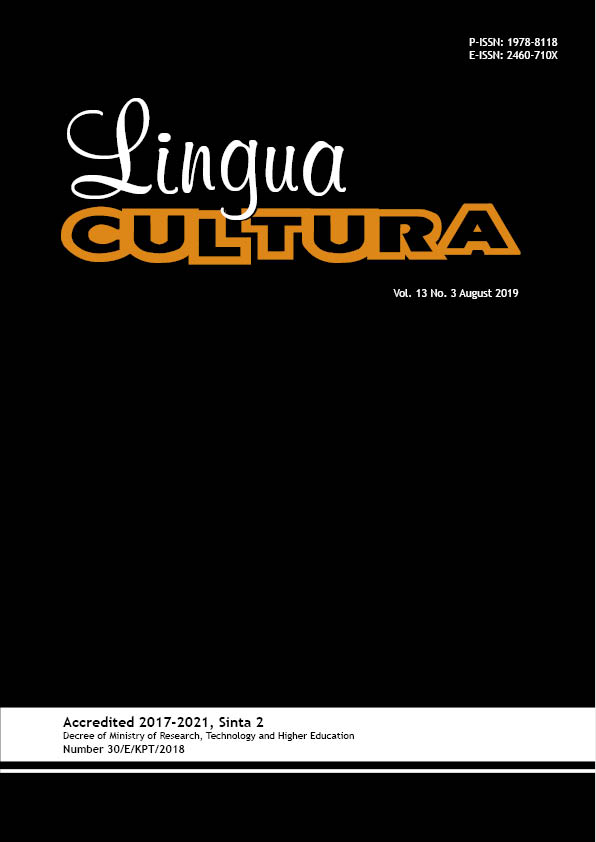Students’ Perceptions on the Use of Google Docs as an Online Collaborative Tool in Translation Class
DOI:
https://doi.org/10.21512/lc.v13i3.5969Keywords:
student perception, google docs, online collaborative, translation classAbstract
The research aimed at investigating students’ perceptions and experiences of using Google Docs in the translation class. Google Docs provided characteristics that can be used to promote peer interaction. However, the use of Google Docs as teaching and learning media was rarely conducted and still limited to teaching writing in Indonesia. Google Docs was commonly used by the translator to translate collaboratively, so the students worked together in a small group to solve and discuss the translation assignment by using some features through Google Docs. These activities were expected to enhance collaboration among them. This research employed a qualitative descriptive study as the research design. The questionnaire was used as the instrument to collect the data that involved fifty students (N = 50) as the participant. The results of this research show that students have a positive response to the use of Google Docs in translation class. It indicates that Google Docs is a suitable tool that can be used for educational purposes.
References
Alsubaie, J., & Ashuraidah, A. (2017). Exploring writing individually and collaboratively using Google Docs in EFL context. Canadian Center of Science and Education, 10(10), 10-30. doi: 10.5539/elt.v10n10p10.
Balakrishnan, B. (2014). Online computer supported collaborative learning (CSCL) for engineering students: a case study in Malaysia. In Computer Applications in Engineering Education (pp. 1-11). doi: 10.1002/cae.21605.
Chu, S. K. W., & Kennedy, D. M. (2011). Using online collaborative tools for groups to co-construct knowledge. Online Information Review, 35(4), 581–597.
Dekeyser, S., & Watson, R. (2006). Extending Google Docs to collaborate on research papers. Technical report. Queensland: The University of Southern Queensland.
Ebadi, S., & Rahimi, M. (2017). Exploring the impact of online peer-editing using Google Docs on EFL learners’ academic writing skills: A mixed metods study. Computer Assisted Language Learning, 30(8), 787–815. https://doi.org/10.1080/09588221.2017.1363056.
Hartono, R. (2015). Teaching translation through the interactive web. Language Circle: Journal of Language and Literature, 9(2), 129-140.
Jannah, K. (2017). Using Google Docs as online collaborative writing platform for the development of students’ writing skill. Master Thesis. Bandung: Universitas Pendidikan Indonesia.
Kessler, G., Bikowski, D., & Boggs, J. (2012). Collaborative writing among second language learners in academic web-based projects. Language Learning & Technology, 16(1), 91–109.
Kusmayadi, Y. (2014). The use of Google Translate as a learning media for improving students’ translation skill. Master Thesis. Bandung: Universitas Pendidikan Indonesia.
Larson, M. L. (1984). Meaning-based translation: a guide to cross-language equivalence. Maryland: University Press of America.
Liu, S. H. J., & Lan, Y. J. (2016). Social constructivist approach to web-based EFL learning: Collaboration, motivation, and perception on the use of Google Docs. Educational Technology & Society, 19(1), 171–186.
Mansor, A. Z. (2012). Google Docs as a collaborating tool for academicians. Procedia - Social and Behavioral Sciences, 59, 411–419.
Newmark, P. (1988). A textbook of translation. New Jersey: Prentice Hall.
Reyna, J. (2013). Google Docs in higher education. In Cases on Online Learning Communities and Beyond: Investigations and Applications (pp. 150–166). Pennsylvania: IGI Global.
Sofyan, R., & Tarigan, B. (2016). The contribution of selfcorrections to translation quality. Revisiting Cultural Issues in the Translation and Interpreting Industry. Medan: Universitas Sumatera Utara.
Suwantarathip, O., & Wichadee, S. (2014). The effects of collaborative writing activity using Google Docs on students’ writing abilities. Turkish Online Journal of Educational Technology, 13(2), 148-156.
Vygotsky, L. S. (1978). Mind in society: The development of higher psychological processes. Cambridge: Harvard University Press.
Woodrich, M., & Fan, Y. (2017). Google Docs as a tool for collaborative writing in the middle school classroom. Journal of Information Technology Education: Research, 16, 391–410.
Yang, C. C. R. (2010). Using Google Docs to facilitate collaborative writing in an English language classroom practice. TESL-EJ, 14(3), 1–6.
Zhou, W., Simpson, E., & Domizi, D. P. (2012). Google Docs in an out-of-class collaborative writing activity. International Journal of Teaching and Learning in Higher Education, 24(3), 359–375.
Downloads
Published
How to Cite
Issue
Section
License
Authors who publish with this journal agree to the following terms:
a. Authors retain copyright and grant the journal right of first publication with the work simultaneously licensed under a Creative Commons Attribution License - Share Alike that allows others to share the work with an acknowledgment of the work's authorship and initial publication in this journal.
b. Authors are able to enter into separate, additional contractual arrangements for the non-exclusive distribution of the journal's published version of the work (e.g., post it to an institutional repository or publish it in a book), with an acknowledgment of its initial publication in this journal.
c. Authors are permitted and encouraged to post their work online (e.g., in institutional repositories or on their website) prior to and during the submission process, as it can lead to productive exchanges, as well as earlier and greater citation of published work.
USER RIGHTS
All articles published Open Access will be immediately and permanently free for everyone to read and download. We are continuously working with our author communities to select the best choice of license options, currently being defined for this journal as follows: Creative Commons Attribution-Share Alike (CC BY-SA)


















